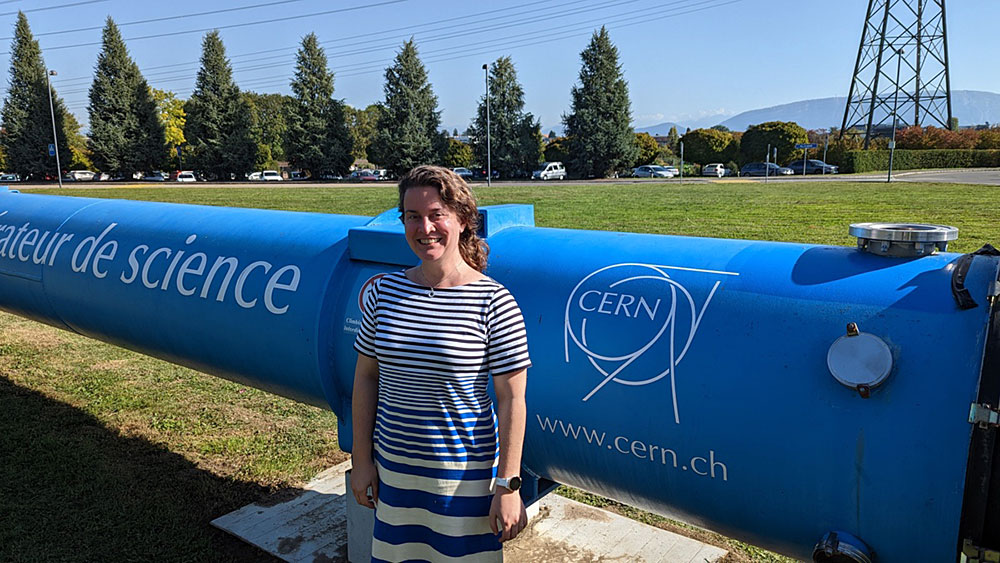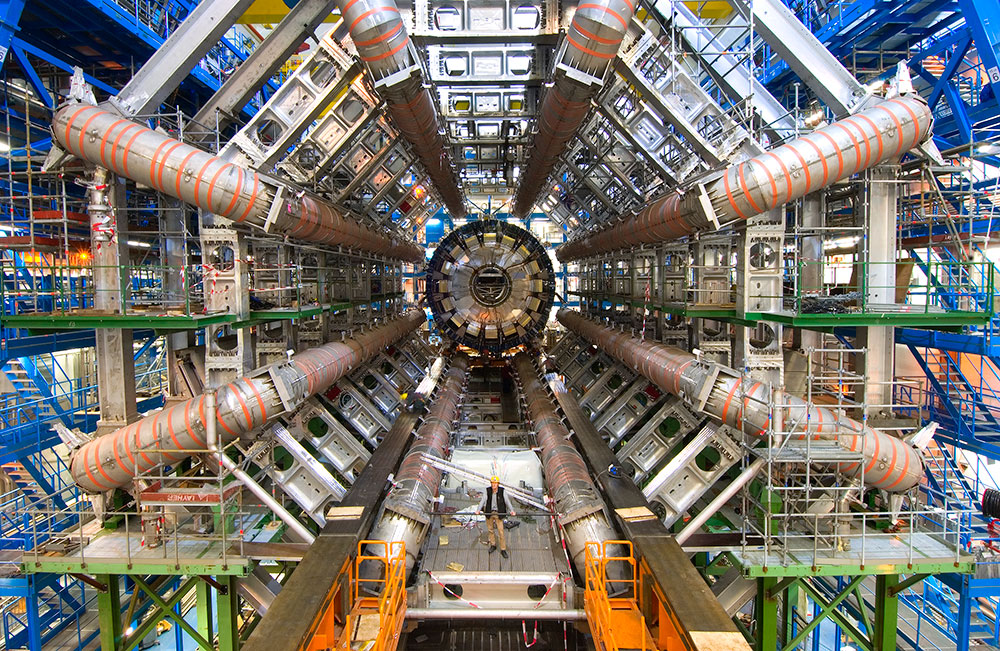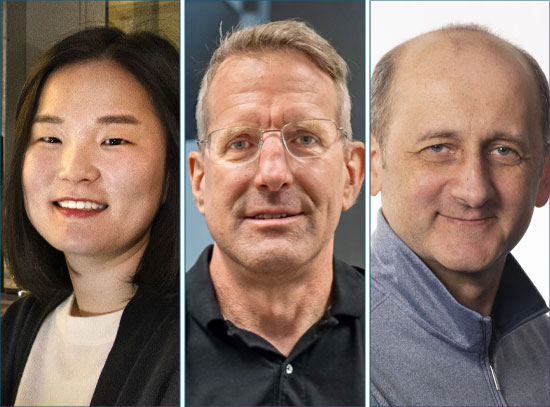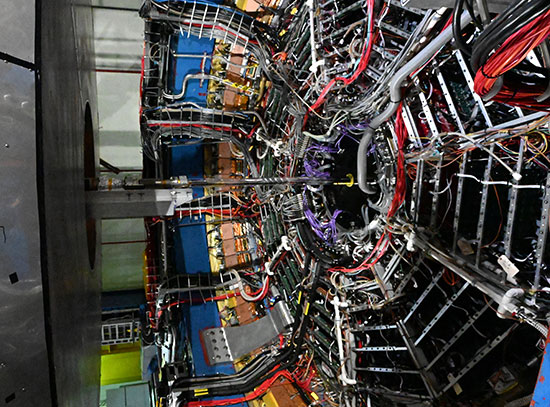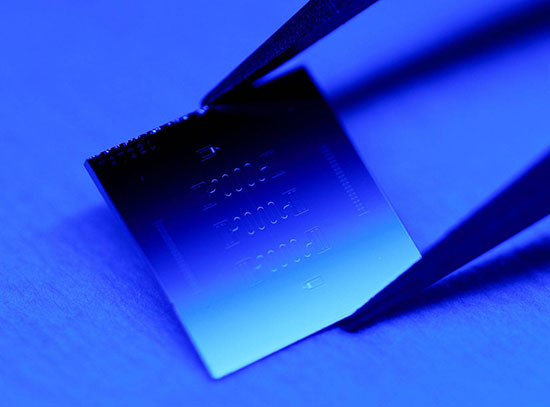Liza Brost Unmasks Mysteries of the Higgs Boson
Brookhaven Lab physicist Liza Brost traveled across the pond to unravel a key piece of particle physics
October 24, 2022
Elizabeth (Liza) Brost, associate physicist at the U.S. Department of Energy’s (DOE) Brookhaven National Laboratory, has dedicated a big part of her life to a tiny particle. She is studying the Higgs boson, a key piece of the particle physics puzzle that describes the fundamental makeup of the universe—the Standard Model.
Brost is currently stationed at CERN’s Large Hadron Collider (LHC) in Geneva, Switzerland, where two experiments first co-observed the Higgs boson in 2012—the CMS experiment and the ATLAS experiment. Brookhaven Lab is the nation’s host laboratory for the ATLAS experiment and plays many roles in this international collaboration, from the detector’s design and construction to the experiment’s data storage and analysis.
Brost herself is a specialist in physics data analysis—using powerful computers to sift through mountains of data from each particle collision at ATLAS to make conclusions about the Higgs boson. She looks for evidence of the Higgs boson’s alignment to the Standard Model and further explores its role in the universe.
“It’s really fun to have this new particle that we can analyze in detail,” said Brost. “We get to see what it is, how it behaves, and how it could change our understanding of how the universe works!”
A Higgs Detective
Brost recalls being interested in science and mathematics from a young age. She studied physics as an undergraduate at Grinnell College, where she also took part in high-energy physics research programs during her summers.
“I spent one of my summers working on the STAR experiment at Brookhaven Lab’s Relativistic Heavy Ion Collider (RHIC) through the Research Experience for Undergraduates program at Purdue University,” said Brost. At STAR, Brost was introduced to the world of large-scale physics experiments. Specifically, she studied data from simulated gold-gold ion collisions at RHIC to assess the performance of a potential upgrade to the STAR detector. “I was hooked ever since.”
Brost continued her studies in physics as a graduate student at the University of Oregon in 2010. There, she studied physics beyond the Standard Model, looking for explanations to the field’s unanswered questions.
The Standard Model is physicists’ best guess at how the universe works. It defines the basic building blocks (particles) that make up the universe and describes how they interact through a set of fundamental forces. One of these particles is the Higgs boson, which was first theorized in the 1960s to give all the fundamental particles in the universe their mass.
“The Higgs boson was a huge missing piece of the puzzle at the time,” said Brost. “Before the LHC started, physicists weren’t able to produce enough energy in collisions to find the Higgs boson.”
Early in her career, Brost was fascinated by the search for the Higgs. She joined the ATLAS experiment in 2011 and moved to CERN on July 3, 2012—just one day before the ATLAS and CMS experiments announced their first observations of the Higgs boson!
“I was fascinated by the Higgs discovery ten years ago,” said Brost. “However, many questions about the Higgs boson still remain that we are looking to solve.” Since then, Brost has dedicated herself to finding out all about the Higgs boson through further analyses.
Brost has remained a part of the ATLAS experiment since 2011, and she completed her PhD in 2016. She then joined Brookhaven Lab’s Omega Group in 2019, where she remains stationed in Switzerland. Brost had experience operating the ATLAS detector, and now focuses on data analysis and detector upgrades.
“I get to work with Brookhaven Lab’s Physics Department and Computational Science Initiative even when I’m across the pond,” said Brost. “We’re looking into complex computer algorithms and powerful hardware upgrades to help sift through the immense amounts of data coming from ATLAS faster now than ever before.”
ATLAS: A Large Higgs Camera
The particle observed in 2012 by the ATLAS and CMS collaborations was consistent with some of the Standard Model’s predicted properties of the Higgs boson, such as charge and spin, but it takes further work to confirm whether this particle is actually the same Higgs boson predicted by the Standard Model. Exploring such a big physics mystery requires physicists like Brost to produce and collect data on more and more Higgs bosons.
The LHC—the world’s highest-energy particle collider and the only one currently capable of creating Higgs bosons—collides protons at 13.6 trillion electronvolts, or teraelectronvolts (TeV). One TeV is about the energy of motion of a flying mosquito.
Each of the two beams travel in opposite directions at nearly the speed of light through a ring-shaped “beam pipe” and collide at four points along the ring. Those collision points coincide with the location of four large particle detectors, including ATLAS.
Standing at over 20 meters tall and 40 meters wide, ATLAS nearly forms a cylinder that wraps around the LHC beam pipe. As the proton beams collide at the center of the ATLAS detector, it captures the products of the collision as they move away from the center of the beam pipe.
“You can think of ATLAS as a giant three-dimensional camera,” said Brost. “We’re essentially taking millions of pictures per second to see what happens.”
Each proton-proton collision occurs at extremely high energies and produces a variety of different particles, including the more massive Higgs bosons. This link between the amount of energy involved and the amount of matter (its mass) created in a collision is explained by Einstein’s famous formula, E=mc2.
“We can get a lot of information about the Higgs boson from ATLAS,” said Brost. “We can learn about its physical properties—its mass, spin, and charge—as well as its behavior—how it couples with itself and other elementary particles, how stable it is, and the field that it creates.”
As Brost and her team collect data on newly made Higgs bosons, they compare them to the predictions made using the Standard Model. The goal: to fully verify its existence, or spot holes that may lead to further discoveries.
Making Improvements
Particle physicists from around the world plan to continue collecting data on the Higgs boson as several improvements to the LHC will be implemented to create and detect Higgs bosons more efficiently.
An upgrade of the LHC beam’s energy from 13.6 to 14 TeV is the first on the list. Although it’s a small increase, Brost notes that the added power can increase the likelihood of observing certain Higgs behaviors, like its ability to form in pairs. Observing such a behavior would further verify that the Higgs boson first seen in 2012 matches the particle predicted by the Standard Model.
“Elementary particles are often produced in pairs—one matter and one antimatter,” said Brost. “When matter and antimatter come into contact, they annihilate—but everything around us is made of only matter and still manages to exist. This tells us that something different happened at the creation of the universe that separates the two types of particles.”
“Higgs pair production can tell us about the field many Higgs bosons altogether create,” said Brost. “If that field is any different than the one predicted by the Standard Model, it could imply that something during the creation of the universe happened to have it made of matter, not antimatter.”
The number of collisions that the LHC can create at the same time, or its instantaneous luminosity, will also be upgraded. Brost says that the combination of higher energy, more collisions, and more running time will give physicists more data to work with and more opportunities to observe rare particles.
However, accelerator upgrades will be tough on the detectors—including ATLAS—if they are not upgraded as well.
“The detectors need new inner trackers, which take a lot of radiation damage being right by the beam,” said Brost.
Identifying the most useful information from the wealth of data produced by ATLAS is a monumental task, so physicists have upgraded the detector’s “trigger system” to make quicker decisions on which collisions should be kept or discarded. ATLAS upgraded the detector hardware, firmware, and software to help it handle the immense amount of data. Additional upgrades to the LHC’s trigger system are still to come.
“We’ve only collected five percent of the data that we expect to collect from the LHC so far,” said Brost. With each upgrade and each successive LHC run, Brost is hopeful for what can be learned about the Higgs boson in the coming years.
A Global Effort
The ATLAS Collaboration is a global effort with over 5,500 contributors from 245 institutions in 42 countries. Such an undertaking can get challenging to manage.
“With so many collaborators spread throughout the world, it does get challenging to coordinate our schedules,” said Brost. “However, it is truly amazing to have the opportunity to work with a diverse group of experts with many different ideas.”
“ATLAS has people with all kinds of skill sets,” said Brost. “There are some that are great at developing software and analyzing data, and others who are great with designing detector parts or sharing our findings. We really need experts in numerous disciplines to make all of this happen.”
In October, Brost will take on a new role as convener for the ATLAS Higgs and Diboson Searches (HDBS) group. She will be coordinating with more than 500 ATLAS members to help showcase their findings during the LHC’s third run, which began just after the 10-year-Higgs-discovery anniversary.
Looking into the future, Brost is hopeful that many discoveries will be made following the continued upgrades and experiments at the LHC.
“We’ve learned so much with the LHC’s first two runs,” said Brost. “Imagine what we can find in the next twenty years!”
Brookhaven National Laboratory is supported by the Office of Science of the U.S. Department of Energy. The Office of Science is the single largest supporter of basic research in the physical sciences in the United States and is working to address some of the most pressing challenges of our time. For more information, visit science.energy.gov.
Follow @BrookhavenLab on Twitter or find us on Facebook.
2022-20798 | INT/EXT | Newsroom




